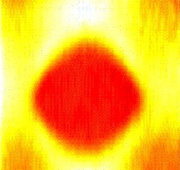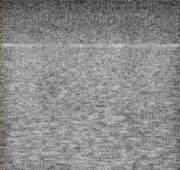Identification of tissue parameters using ultrasound vibro-elastography
With Hani Eskandari, Reza Zahiri, and Ali Baghani (PhD graduates, now working at Ultrasonix). Funded by an NSERC Strategy Partnership Grant. Real-time strain imaging of elastography phantom shown here. Vibro-elastography is an extension of static elastography and was developed with Emre Turgay and Rob Rohling. As illustrated below, the method consists of applying broad-band low-frequency (typically <30Hz) compression waves to tissue by a vibrator, measuring tissue displacement, and either fitting a parametric model to the relative tissue motion, or computing a frequency response from the relative tissue motion. From left to right, the figures below show: the low-frequency asymptotes of these frequency responses in a soft-hard-soft cubic 5cm3 phantom (256×256), the conventional B-mode ultrasound image which does not show any contrast, and the magnitudes of the relative motion responses of tissue at different depths relative to a tissue patch near the vibrator (located at the top of the images), as a function of frequency. Note that in the hard region responses are closer together and change more with frequency. With an 8MHz transducer, stiffness changes of 10% and hard(twice as stiff) inclusions of 0.5mm can be detected. [Turgay, Salcudean and Rohling 2006] We are developing
- fast estimation algorithms for real-time vibro-elastography imaging
- methods of deriving images from the frequency responses of relative tissue motion
- approaches to the inverse problem based on dynamic finite elements
See papers with Eskandari, Zahiri, Baghani for recent work.

